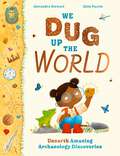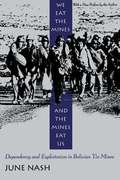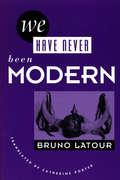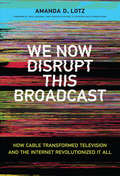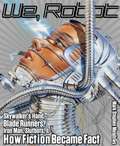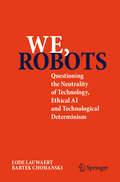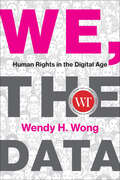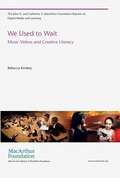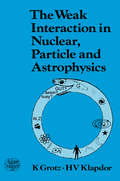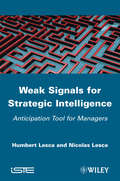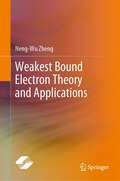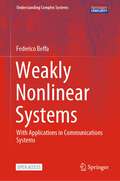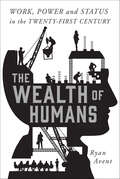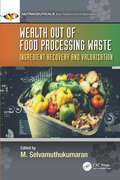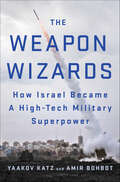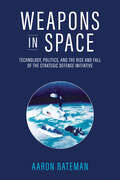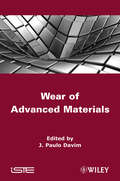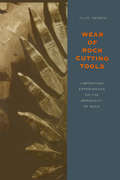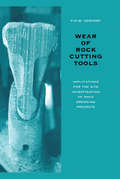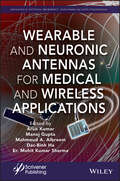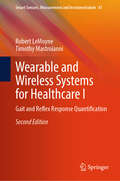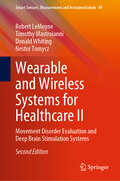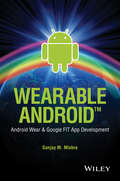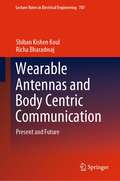- Table View
- List View
We Dug Up the World: Unearth Amazing Archaeology Discoveries
by Alexandra StewartYou can find AMAZING things when you DIG. Shells, bottle tops and slimy snails. But can you imagine what would happen if one day you dug up something extra special, something that had an amazing story to tell about what life was like a long time ago . . .People have found some INCREDIBLE things by digging deep underground. Magnificent mummies from long, long ago. Dinosaur bones washed up on the beach. Beautiful cities buried by volcano ash. Mighty meteors from beyond the Milky Way. And even an ancient poo. Team up with archaeologists from around the world and travel through time to learn about fantastic historical artefacts. From Tutankhamun's tomb to the Titanic, and dinosaur bones on the beach to Pompeii, children will discover something new on every page and delight in learning about how the world used to be.
We Eat the Mines and the Mines Eat us: Dependency and Exploitation in Bolivian Tin Mines
by June NashIn this powerful anthropological study of a Bolivian tin mining town, Nash explores the influence of modern industrialization on the traditional culture of Quechua-and-Aymara-speaking Indians.
We Garden Together!: Projects for Kids: Learn, Grow, and Connect with Nature
by Jane Hirschi Educators at City SproutsThis colorful activity book invites kids ages 3 to 6 to explore the world of plants and how they grow through creative hands-on activities developed by City Sprouts, a leading educational organization focused on introducing urban kids to the wonders of the garden and promoting equity in science education.
We Have Never Been Modern
by Bruno LatourWith the rise of science, we moderns believe, the world changed irrevocably, separating us forever from our primitive, premodern ancestors. But if we were to let go of this fond conviction, Bruno Latour asks, what would the world look like? His book, an anthropology of science, shows us how much of modernity is actually a matter of faith. What does it mean to be modern? What difference does the scientific method make? The difference, Latour explains, is in our careful distinctions between nature and society, between human and thing, distinctions that our benighted ancestors, in their world of alchemy, astrology, and phrenology, never made. But alongside this purifying practice that defines modernity, there exists another seemingly contrary one: the construction of systems that mix politics, science, technology, and nature. The ozone debate is such a hybrid, in Latour's analysis, as are global warming, deforestation, even the idea of black holes. As these hybrids proliferate, the prospect of keeping nature and culture in their separate mental chambers becomes overwhelming--and rather than try, Latour suggests, we should rethink our distinctions, rethink the definition and constitution of modernity itself. His book offers a new explanation of science that finally recognizes the connections between nature and culture--and so, between our culture and others, past and present. Nothing short of a reworking of our mental landscape. We Have Never Been Modern blurs the boundaries among science, the humanities, and the social sciences to enhance understanding on all sides. A summation of the work of one of the most influential and provocative interpreters of science, it aims at saving what is good and valuable in modernity and replacing the rest with a broader, fairer, and finer sense of possibility.
We Now Disrupt This Broadcast: How Cable Transformed Television and the Internet Revolutionized It All (The\mit Press Ser.)
by Amanda D. LotzThe collision of new technologies, changing business strategies, and innovative storytelling that produced a new golden age of TV.Cable television channels were once the backwater of American television, programming recent and not-so-recent movies and reruns of network shows. Then came La Femme Nikita, OZ, The Sopranos, Mad Men, Game of Thrones, and The Walking Dead. And then, just as “prestige cable” became a category, came House of Cards and Netflix, Hulu, Amazon Video, and other Internet distributors of television content. What happened? In We Now Disrupt This Broadcast, Amanda Lotz chronicles the collision of new technologies, changing business strategies, and innovative storytelling that produced an era termed “peak TV.”Lotz explains that changes in the business of television expanded the creative possibilities of television. She describes the costly infrastructure rebuilding undertaken by cable service providers in the late 1990s and the struggles of cable channels to produce (and pay for) original, scripted programming in order to stand out from the competition. These new programs defied television conventions and made viewers adjust their expectations of what television could be. Le Femme Nikita offered cable's first antihero, Mad Men cost more than advertisers paid, The Walking Dead became the first mass cable hit, and Game of Thrones was the first global television blockbuster. Internet streaming didn't kill cable, Lotz tells us. Rather, it revolutionized how we watch television. Cable and network television quickly established their own streaming portals. Meanwhile, cable service providers had quietly transformed themselves into Internet providers, able to profit from both prestige cable and streaming services. Far from being dead, television continues to transform.
We, Robot: Skywalker's Hand, Blade Runners, Iron Man, Slutbots, and How Fiction Became Fact
by Mark Stephen MeadowsExamining favorite science fiction tales to reveal which robots actually exist today--and what's coming tomorrow--"We, Robot" asks: How close to becoming reality are our favorite science fiction robots? And what might be the real-life consequences of their existence?
We, robots: Questioning the Neutrality of Technology, Ethical AI and Technological Determinism
by Lode Lauwaert Bartek ChomanskiThis book takes a philosophical look at traditional technological tools such as hammers and drills as well as the modern: autonomous cars, ChatGPT, smartphones, apps, steam engines, nuclear power plants, computers, and many other systems that surround us. The three main questions tackled are: Is technology neutral? Or is the design often intertwined with a Western or gendered perspective? What are the ethical risks of AI? Is it necessarily biased? Is the climate problem linked to smart technologies? Is technological determinism correct? In other words, is the world controlled by engineers since the digital revolution, or are their inventions merely a product of society? Lode Lauwaert and Bartek Chomanski offer an idiosyncratic perspective on technology and AI. The result is a nuanced and critical view of the key themes of our time. This book appeals broadly to students, researchers as well as non-academic audiences for an introduction to the philosophy of technology and AI. “This book explores key themes that all revolve around the idea that technology is not neutral. This is a message for all of us. Because technology is us.” Mark Coeckelbergh, University of Vienna
We, the Data: Human Rights in the Digital Age
by Wendy H. WongA rallying call for extending human rights beyond our physical selves—and why we need to reboot rights in our data-intensive world.Our data-intensive world is here to stay, but does that come at the cost of our humanity in terms of autonomy, community, dignity, and equality? In We, the Data, Wendy H. Wong argues that we cannot allow that to happen. Exploring the pervasiveness of data collection and tracking, Wong reminds us that we are all stakeholders in this digital world, who are currently being left out of the most pressing conversations around technology, ethics, and policy. This book clarifies the nature of datafication and calls for an extension of human rights to recognize how data complicate what it means to safeguard and encourage human potential. As we go about our lives, we are co-creating data through what we do. We must embrace that these data are a part of who we are, Wong explains, even as current policies do not yet reflect the extent to which human experiences have changed. This means we are more than mere &“subjects&” or &“sources&” of data &“by-products&” that can be harvested and used by technology companies and governments. By exploring data rights, facial recognition technology, our posthumous rights, and our need for a right to data literacy, Wong has crafted a compelling case for engaging as stakeholders to hold data collectors accountable. Just as the Universal Declaration of Human Rights laid the global groundwork for human rights, We, the Data gives us a foundation upon which we claim human rights in the age of data.
We Used to Wait
by Rebecca KinskeyMusic videos were once something broadcast by MTV and received on our TV screens. Today, music videos are searched for, downloaded, and viewed on our computer screens -- or produced in our living rooms and uploaded to social media. In We Used to Wait, Rebecca Kinskey examines this shift. She investigates music video as a form, originally a product created by professionals to be consumed by nonprofessionals; as a practice, increasingly taken up by amateurs; and as a literacy, to be experimented with and mastered. Kinskey offers a short history of the music video as a communicative, cultural form, describing the rise and fall of MTV's Total Request Live and the music video's resurgence on YouTube. She examines recent shifts in viewing and production practice, tracing the trajectory of music video director Hiro Murai from film student and dedicated amateur in the 1990s to music video professional in the 2000s. Investigating music video as a literacy, she looks at OMG! Cameras Everywhere, a nonprofit filmmaking summer camp run by a group of young music video directors. The OMG! campers and counselors provide a case study in how cultural producers across several generations have blurred the line between professional and amateur. Their everyday practices remake the notion of literacy, not only by their collaborative and often informal efforts to impart and achieve literacy but also by expanding the definition of what is considered a valuable activity, worthy of dedicated, pleasurable pursuit.
The Weak Interaction in Nuclear, Particle, and Astrophysics
by K. GrotzThis book provides insight into concept of the weak interaction and its integration into the conceptual structure of elementary particle physics. It exhibits the important role of the weak interaction in nuclear, particle and astrophysics together with the close connection between these areas.
Weak Signals for Strategic Intelligence: Anticipation Tool for Managers
by Humbert Lesca Nicolas LescaThe expression "We did not see it coming!" has often been heard in recent years from decision makers at the highest levels of the private and public sectors. Yet there were actually early warning signals, but they were often ignored due to a lack of appropriate methodology. Focusing on the concept of a weak signal, this book provides methods for anticipating problems and dealing with blind spots. Along with examples of this concept, the authors provide answers to questions of feasibility, including how to recognize a weak signal, and how to exploit it. Numerous applications are also presented throughout.
Weakest Bound Electron Theory and Applications
by Neng-Wu ZhengThis monograph describes the new quantum theory called the weakest bound electron theory (WBE theory) proposed by Prof. Neng-Wu Zheng and its applications. It starts with the fundamentals of quantum mechanics and then illustrates the key points of WBE theory and the mathematical expressions of WBE theory. Finally, it presents a wide range of applications of WBE theory to the chemical and physical properties of atoms and molecules, including energy levels, transition properties, the difference law of ionization energies etc. It appeals to a broad readership, particularly researchers and academics in chemistry, physics, and materials science.
Weakly Nonlinear Systems: With Applications in Communications Systems (Understanding Complex Systems)
by Federico BeffaThe open access book covers a large class of nonlinear systems with many practical engineering applications. The approach is based on the extension of linear systems theory using the Volterra series. In contrast to the few existing treatments, our approach highlights the algebraic structure underlying such systems and is based on Schwartz’s distributions (rather than functions). The use of distributions leads naturally to the convolution algebras of linear time-invariant systems and the ones suitable for weakly nonlinear systems emerge as simple extensions to higher order distributions, without having to resort to ad hoc operators. The result is a much-simplified notation, free of multiple integrals, a conceptual simplification, and the ability to solve the associated nonlinear differential equations in a purely algebraic way. The representation based on distributions not only becomes manifestly power series alike, but it includes power series as the description of the subclass of memory-less, time-invariant, weakly nonlinear systems. With this connection, many results from the theory of power series can be extended to the larger class of weakly nonlinear systems with memory. As a specific application, the theory is specialised to weakly nonlinear electric networks. The authors show how they can be described by a set of linear equivalent circuits which can be manipulated in the usual way. The authors include many real-world examples that occur in the design of RF and mmW analogue integrated circuits for telecommunications. The examples show how the theory can elucidate many nonlinear phenomena and suggest solutions that an approach entirely based on numerical simulations can hardly suggest. The theory is extended to weakly nonlinear time-varying systems, and the authors show examples of how time-varying electric networks allow implementing functions unfeasible with time-invariant ones. The book is primarily intended for engineering students in upper semesters and in particular for electrical engineers. Practising engineers wanting to deepen their understanding of nonlinear systems should also find it useful. The book also serves as an introduction to distributions for undergraduate students of mathematics.
The Wealth of Humans: Work, Power, and Status in the Twenty-First Century
by Ryan AventNone of us has ever lived through a genuine industrial revolution. Until now. Digital technology is transforming every corner of the economy, fundamentally altering the way things are done, who does them, and what they earn for their efforts. In The Wealth of Humans, Economist editor Ryan Avent brings up-to-the-minute research and reporting to bear on the major economic question of our time: can the modern world manage technological changes every bit as disruptive as those that shook the socioeconomic landscape of the 19th century?Traveling from Shenzhen, to Gothenburg, to Mumbai, to Silicon Valley, Avent investigates the meaning of work in the twenty-first century: how technology is upending time-tested business models and thrusting workers of all kinds into a world wholly unlike that of a generation ago. It's a world in which the relationships between capital and labor and between rich and poor have been overturned.Past revolutions required rewriting the social contract: this one is unlikely to demand anything less. Avent looks to the history of the Industrial Revolution and the work of numerous experts for lessons in reordering society. The future needn't be bleak, but as The Wealth of Humans explains, we can't expect to restructure the world without a wrenching rethinking of what an economy should be.
Wealth out of Food Processing Waste: Ingredient Recovery and Valorization (Nutraceuticals)
by M. SelvamuthukumaranHigh amounts of waste are generated daily in various food processing industries inclusing seed, pomace, pit, peel, germ, husk, broken pulses, sludge, skin, bones, blood, feathers, wash water, and spent residue, among others. Several tons of generated waste can be effectively used to manufacture or recover such value-added by-products as fibers, antioxidants, proteins, vitamins and minerals, biofilms, fertilizers, and animal feed. While food processing- generated waste may lead to health and environmental hazards, it is critical to identify proper protocols to recover valuable ingredients from waste, thereby creating wealth in the society.Wealth out of Food Processing Waste identifies and describes the proper protocols to recover valuable ingredients from waste, thereby creating wealth in society. The effective utilization of waste can generate income for the entrepreneur, lead to more employment for society, enhance fertility of soil, reduce environmental pollution, conserve resources, and help augment national economies to a greater extent.Key Features: Provides in-depth knowledge about conversion of waste derived from various food processing industries into various value-added products Highlights the extraction of antioxidants and functional food ingredients from industrial food waste Presents current and emerging trends using biotechnological approaches for conversion of waste into various value-added products This book provides food industry personnel, scientists, food engineers, biotechnologists, research scholars, and students with strategies for effective utilization of waste from various food processing industries.
The Weapon Wizards: How Israel Became A High-Tech Military Superpower
by Yaakov Katz Amir Bohbot"A lively account of Israel's evolving military prowess...if The Weapon Wizards were a novel, it would be one written by Horatio Alger; if it were a biblical allegory, it would be the story of David and Goliath." —The New York Times Book ReviewFrom drones to satellites, missile defense systems to cyber warfare, Israel is leading the world when it comes to new technology being deployed on the modern battlefield. The Weapon Wizards shows how this tiny nation of 8 million learned to adapt to the changes in warfare and in the defense industry and become the new prototype of a 21st century superpower, not in size, but rather in innovation and efficiency—and as a result of its long war experience. Sitting on the front lines of how wars are fought in the 21st century, Israel has developed in its arms trade new weapons and retrofitted old ones so they remain effective, relevant, and deadly on a constantly-changing battlefield. While other countries begin to prepare for these challenges, they are looking to Israel—and specifically its weapons—for guidance. Israel is, in effect, a laboratory for the rest of the world. How did Israel do it? And what are the military and geopolitical implications of these developments? These are some of the key questions Yaakov Katz and Amir Bohbot address. Drawing on a vast amount of research, and unparalleled access to the Israeli defense establishment, this book is a report directly from the front lines.
Weapons in Space: Technology, Politics, and the Rise and Fall of the Strategic Defense Initiative
by Aaron BatemanA new and provocative take on the formerly classified history of accelerating superpower military competition in space in the late Cold War and beyond.In March 1983, President Ronald Reagan shocked the world when he established the Strategic Defense Initiative (SDI), derisively known as &“Star Wars,&” a space-based missile defense program that aimed to protect the US from nuclear attack. In Weapons in Space, Aaron Bateman draws from recently declassified American, European, and Soviet documents to give an insightful account of SDI, situating it within a new phase in the militarization of space after the superpower détente fell apart in the 1970s. In doing so, Bateman reveals the largely secret role of military space technologies in late–Cold War US defense strategy and foreign relations.In contrast to existing narratives, Weapons in Space shows how tension over the role of military space technologies in American statecraft was a central source of SDI&’s controversy, even more so than questions of technical feasibility. By detailing the participation of Western European countries in SDI research and development, Bateman reframes space militarization in the 1970s and 1980s as an international phenomenon. He further reveals that even though SDI did not come to fruition, it obstructed diplomatic efforts to create new arms control limits in space. Consequently, Weapons in Space carries the legacy of SDI into the post–Cold War era and shows how this controversial program continues to shape the global discourse about instability in space—and the growing anxieties about a twenty-first-century space arms race.
Wear of Advanced Materials (Wiley-iste Ser. #9)
by J. Paulo DavimRecent advances into the wear of advanced materials In general, wear is currently defined as “the progressive loss of material from the operating surface of a body occurring as a result of relative motion at the surface”. It is related to surface interactions and more specifically to the form of contact due to relative motion. Wear is rarely catastrophic but does reduce the operating efficiency of machine components and structures. At this time of economic crisis, this is a very important field of study because of the huge impact the wear of materials has on the economy. The purpose of this book is to present a collection of examples illustrating the state of the art and research developments into the wear of advanced materials in several applications. It can be used as a research book for a final undergraduate engineering course (for example into materials, mechanics, etc.) or as the focus of the effect of wear on advanced materials at a postgraduate level. It can also serve as a useful reference for academics, biomaterials researchers, mechanical and materials engineers, and professionals in related spheres working with tribology and advanced materials.
Wear of Rock Cutting Tools: Laboratory Experiments on the Abrasivity of Rock
by H.J.R. DekethThis text provides an insight into the wear processes which take place during the cutting of rock with steel cutting tools. Rock cutting experiments in different rock types leading to a new approach to the estimation of rock cutting tool wear are described.
Wear of Rock Cutting Tools: Implications for the Site Investigation of Rock Dredging Projects
by P.N.W. VerhoefThis text deals with the dredging of rock by large cutter suction dredgers. The rock properties influencing the mechanical cutting of rock and the wear of cutting teeth are examined, and to verify the model of mechanical rock excavation developed, case studies of dredging projects were performed.
Wearable and Neuronic Antennas for Medical and Wireless Applications (Advances in Antenna, Microwave, and Communication Engineering)
by Arun Kumar Manoj Gupta Mahmoud A. Albreem Dac-Binh Ha Mohit Kumar SharmaWEARABLE AND NEURONIC ANTENNAS FOR MEDICAL AND WIRELESS APPLICATIONS This new volume in this exciting new series, written and edited by a group of international experts in the field, covers the latest advances and challenges in wearable and neuronic antennas for medical and wireless applications. Antenna development and engineering is changing at a rapid pace, and it is incredibly important that engineers, scientists, and students in the field have a valuable reference work to consult. Students are able to use this book as a learning tool, and professors and industrial short courses are able to use it as a textbook. Covering all of the advances and developments of wearable and neuronic antennas for medical and wireless applications, this outstanding new volume offers information not available anywhere else in any other format. Covering new research and development of antenna designs never seen before, this volume, written and edited by a team of experts in the field, breaks new ground, offering new solutions to engineering and scientific problems to experts in the field, while providing the full theoretical and conceptual background for the practical applications. Whether for the veteran engineer or scientist, the student, or a manager or other technician working in the field, this volume is a must-have for any library.
Wearable and Wireless Systems for Healthcare I: Gait and Reflex Response Quantification (Smart Sensors, Measurement and Instrumentation #47)
by Timothy Mastroianni Robert LeMoyneThis book is the second edition of the one originally published in 2017. The original publication features the discovery of numerous novel applications for the use of smartphones and portable media devices for the quantification of gait, reflex response, and an assortment of other concepts that constitute first-in-the-world applications for these devices. Since the first edition, numerous evolutions involving the domain of wearable and wireless systems for healthcare have transpired warranting the publication of the second edition. This volume covers wearable and wireless systems for healthcare that are far more oriented to the unique requirements of the biomedical domain. The paradigm-shifting new wearables have been successfully applied to gait analysis, homebound therapy, and quantifiable exercise. Additionally, the confluence of wearable and wireless systems for healthcare with deep learning and neuromorphic applications for classification is addressed. The authors expect that these significant developments make this book valuable for all readers.
Wearable and Wireless Systems for Healthcare II: Movement Disorder Evaluation and Deep Brain Stimulation Systems (Smart Sensors, Measurement and Instrumentation #49)
by Timothy Mastroianni Robert LeMoyne Donald Whiting Nestor TomyczThis book is the second edition of the one originally published in 2019. The original publication features the discovery of numerous novel applications for the use of smartphones and portable media devices for the quantification of deep brain stimulation for the treatment of movement disorders that constitute first-in-the-world applications for these devices. Since the first edition, numerous evolutions involving the domain of wearable and wireless systems for healthcare and deep brain stimulation have transpired warranting the publication of the second edition. This volume covers wearable and wireless systems for healthcare that are far more relevant to the unique requirements of the domain of deep brain stimulation. The paradigm-shifting new wearables comprising attributes of conformability and further miniaturization have been recently applied for the context of deep brain stimulation. Additionally, the subjects of automated optimization for deep brain stimulation and the rampantly expanding additional applications for deep brain stimulation are addressed. The authors expect that these significant developments make this book valuable for all readers.
Wearable Android
by Sanjay M. MishraSoftware Development/Mobile/Android/Wearable/Fitness Build "Wearable" Applications on the Android Wear and Google Fit Platforms This book covers wearable computing and wearable application development particularly for Android Wear (smartwatches) and Google Fit (fitness sensors). It provides relevant history, background and core concepts of wearable computing and ubiquitous computing, as a foundation for designing/developing applications for the Android Wear and Google Fit platforms. This book is intended for Android wearable enthusiasts, technologists and software developers. Gain insight into "wearables" in the modern consumer ecosystem of a multitude of devices, ubiquitous computing, cloud computing and intelligent personal assistants Learn the Android Wear and Google Fit APIs and jump-start hands-on development including: setting up an Android development environment suitable for Android Wear and Google Fit , setting up smartwatch and fitness devices for development and debugging , writing applications that install and execute on Android Wear (smartwatch) devices , and applications that run on your handheld Android devices and find and connect to fitness sensors and access fitness data, and more Catch up with the new Android 5.0 "Lollipop", Android Studio and the gradle based build system Learn how to write applications for smart watches and fitness sensors on the Android/Google ecosystem. "Sanjay's tome provides a comprehensive and timely treatment of the essential points of current Wearable technology and Android Wearable development techniques. The easygoing and comprehensive examples make this book a joy to discover and a delight to peruse. Highly recommended!" - Rudi Cilibrasi, Computer Scientist "The text provides a rich and immersive overview of the field of Wearable computing that is solidified by the impressive set of examples. I was simultaneously entertained as well as educated, and would highly recommend this book to anyone that is looking to get started with Wearables." - Nathan Blair, Software Engineer & Entrepreneur Sanjay M. Mishra began programming in C on various flavors of Unix in the early 1990s. Over the years he has developed diverse software systems spanning web applications and services, messaging, VoIP, NoSQL databases, as well as mobile and embedded platforms. He has worked for companies such as Intertrust, Eyecon Technologies, CallSource, nVoc (formerly Sandcherry, Inc.) and the Starz Entertainment group.
Wearable Antennas and Body Centric Communication: Present and Future (Lecture Notes in Electrical Engineering #787)
by Shiban Kishen Koul Richa BharadwajThis book presents state-of-the-art technologies, trends and applications with a focus on the healthcare domain for ultra-wideband (3.1–10.6 GHz) and 60 GHz (57–66 GHz) wireless communication systems. Due to various key features such as miniaturized antenna design, low power, high data rate, less effects on the human body, relatively less crowded spectrum, these technologies are becoming popular in various fields of biomedical applications and day-to-day life. The book highlights various aspects of these technologies related to body-centric communication, including antenna design requirements, channel modeling and characterization for WBANs, current fabrication and antenna design strategies for textile, flexible and implanted antennas. Apart from the general requirements and study related to these frequency bands, various application specific topics such as localization and tracking, physical activity recognition and assessment, vital sign monitoring and medical imaging are covered in detail. The book concludes with the glimpses of future aspects of the UWB and 60 GHz technology which includes IoT for healthcare and smart living, novel antenna materials and application of machine learning algorithms for overall performance enhancement.
